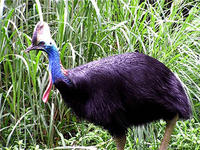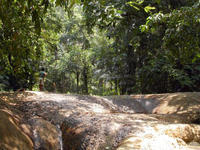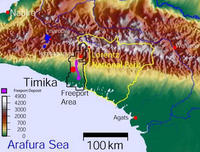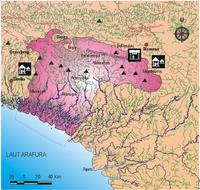You are in: Asia -> Indonesia -> Lorentz National Park, and traditional search or Image Gallery will yield results of this site only
Lorentz National Park
| Site number: | 955 |
|
| Type of site: | Natural | |
| Date: | - | |
| Date of Inscription: | 1999 | |
| Location: | Asia, Indonesia, Province of Papua (formerly Irian Jaya) | |
Up to 75 images are shown here. Click on each for more details or on Image Gallery for more images.
| Description: | The 2.5 million ha Lorentz National Park is South-East Asia’s largest protected area. This is the only protected area in the world that encompasses intact altitudinal zones that stretch continuously - ranging from snowcap to tropical marine environments, including extensive lowland wetlands. The site is positioned where two colliding continental plates meet; the complex geology of the area sees ongoing mountain formation as well as immense sculpting due to glaciation. The area also encloses fossil sites that offer evidence of New Guinea’s evolution of life, a high level of endemism and the highest level of biodiversity in the region. --WHMNet paraphrase from the description at WHC Site, where additional information is available. | |
| Lorentz National Park is located in the Indonesian province of Papua, formerly known as Irian Jaya (western New Guinea). With an area of 25,056 km² (9,674 mi²), it is the largest national park in South-East Asia. In 1999 Lorentz was declared a World Heritage Site by UNESCO. An outstanding example of the biodiversity of New Guinea, Lorentz is one of the most ecologically diverse national parks in the world. It is the only nature reserve in the Asia-Pacific region to contain a full altitudial array of ecosystems spanning from marine areas, mangrove, tidal and freshwater swamp forest, lowland and montane rainforest, alpine areas, and equatorial glaciers. At 4884 meters, Puncak Jaya (formerly Carstensz Pyramid) is the tallest mountain between the Himalayas and the Andes. Birdlife International has called Lorentz Park “probably the single most important reserve in New Guinea” (Birdlife International, 1999). Lorentz Park contains many unmapped and unexplored areas, and is certain to contain many species of plants and animals as yet unknown to Western science. Local communities' ethnobotanical and ethnozoological knowledge of the Lorentz biota is also very poorly documented. The park is named for Hendrikus Albertus Lorentz, a Dutch explorer who passed through the area on his 1909-1910 expedition. --Wikipedia. Text is available under the Creative Commons Attribution-ShareAlike License. | ||
| Source: | http://whc.unesco.org/en/list/955 | |
| Reference: | 1. UNESCO World Heritage Center, Site Page. | |






